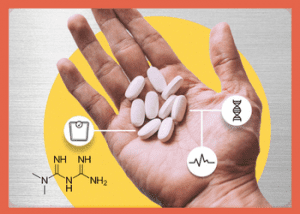Metformin is an oral medication prescribed by doctors to treat Type 2 diabetes, a condition that has become increasingly common in the U.S., with 34 million people living with it and 88 million more having prediabetes.
People suffering from this chronic disorder are also likely to have additional health issues like hypertension, high cholesterol levels, or even cardiovascular disease.
This drug belongs to a group of medications called biguanides that can help these patients manage their symptoms better while reducing their risk of developing serious complications in the long term.
When it comes to diabetes, there are two main classifications: Type 1 and Type 2. For those diagnosed with the latter, a wide range of oral and injectable medications can be administered for successful blood sugar control over time – which is usually measured by hemoglobin A1C (HbA1C).
Table of Contents
What Can I Take in Place of Metformin?
| Drug name | Uses | Side effects | Dosage |
|---|---|---|---|
| Metformin | Treatment of Type 2 diabetes mellitus | Diarrhea, nausea, vomiting, flatulence | 500 mg – 1,000 mg up to twice daily |
| Precose (acarbose) | Treatment of Type 2 diabetes mellitus | Abdominal pain, diarrhea, flatulence | 25 mg – 100 mg three times daily |
| Januvia (sitagliptin) | Treatment of Type 2 diabetes mellitus | Upper respiratory infection, headache | 100 mg once daily |
| Tradjenta (linagliptin) | Treatment of Type 2 diabetes mellitus | Nasopharyngitis, diarrhea, cough | 5 mg once daily |
| Onglyza (saxagliptin) | Treatment of Type 2 diabetes mellitus | Upper respiratory infection, urinary tract infection, headache | 2.5 mg – 5 mg once daily |
| Victoza (liraglutide) | Treatment of Type 2 diabetes mellitus | Nausea, diarrhea, headache | 1.8 mg once daily |
| Ozempic (semaglutide) | Treatment of Type 2 diabetes mellitus | Nausea, vomiting, diarrhea | 0.25 mg – 1 mg once weekly |
| Trulicity (dulaglutide) | Treatment of Type 2 diabetes mellitus | Nausea, vomiting, diarrhea | 0.75 mg – 4.5 mg once weekly |
| Bydureon Bcise (exenatide) | Treatment of Type 2 diabetes mellitus | Injection site nodule, nausea | 2 mg once weekly |
| Glucotrol XL (glipizide) | Treatment of Type 2 diabetes mellitus | Nausea, diarrhea, constipation | 5 mg – 20 mg once daily |
| Amaryl (glimepiride) | Treatment of Type 2 diabetes mellitus | Headache, flu-like syndrome, nausea | 1 mg – 2 mg once daily |
| Micronase (glyburide) | Treatment of Type 2 diabetes mellitus | Jaundice, skin reactions | 2.5 mg – 20 mg once daily |
| Actos (pioglitazone) | Treatment of Type 2 diabetes mellitus | Upper respiratory tract infection, headache, sinusitis | 15 mg – 45 mg once daily |
How to Switch to a Metformin Alternative
Your physician should always be your first point of contact if you feel that metformin is not the right treatment for your diabetes. It has proven to be a highly effective and economical option, but it should never be abruptly discontinued without consulting with your prescriber; this could lead to hyperglycemia.
 The only viable reason for ceasing the use of metformin would come in the form of an allergic reaction – so make sure to seek medical advice before making any decisions regarding its usage!
The only viable reason for ceasing the use of metformin would come in the form of an allergic reaction – so make sure to seek medical advice before making any decisions regarding its usage!
In order to maintain your health and well-being, an alternative solution for metformin may need to be explored if continuing GI side effects or kidney disease arise.
It is essential that you keep your lab results up-to-date so that any changes in your kidney function can promptly be monitored by a physician.
If the choice of switching medications arises, then they will discuss possible options with you based on their physical assessments.
When choosing a new medication, you’ll have to assess if self-injection is something you are willing to do, the possible side effects of other treatments, and how well your glycemic control is currently working.
The process of dose titration will also take some time as your doctor finds exactly what works for you. Remember that it can be difficult but finding the perfect therapy plan could potentially change your life.
5 Natural Alternatives to Metformin
Metformin is a commonly prescribed medication for the treatment of type 2 diabetes. However, it is not suitable for everyone, and some people may experience unwanted side effects. Fortunately, there are some natural alternatives to metformin that may help manage blood sugar levels.
- Cinnamon: It is a spice that has been shown to help lower blood sugar levels by improving insulin sensitivity. Adding cinnamon to your diet, such as sprinkling it on oatmeal or adding it to tea, maybe a simple way to help manage blood sugar levels.
- Chromium: It is a mineral that has been found to improve insulin sensitivity and help regulate blood sugar levels. Good sources of chromium include broccoli, green beans, and nuts.
- Berberine: Berberine is a compound found in certain plants, including goldenseal and barberry. It has been shown to have a similar effect to metformin by improving insulin sensitivity and reducing blood sugar levels. However, it is important to speak with a healthcare provider before taking berberine as it can interact with some medications.
- N-acetyl-cysteine (NAC): N-acetyl-cysteine, an antioxidant synthesized within the body, has been found to potentially improve insulin sensitivity in women afflicted with PCOS and insulin resistance according to a recent study. Enhancing insulin sensitivity helps to redirect glucose from the blood into cells, thus reducing high sugar levels. An additional study uncovered that NAC not only improves glucose intolerance in diabetic rodents but also acts as an antioxidant and combats inflammation.
- Myo-inositol and D-chiro inositol: Myo- and D-chiro inositol have been scientifically tested for their capacity to enhance insulin sensitivity, thus they are generally recommended to women with PCOS as a means of diminishing symptoms and growing fertility. Furthermore, Inositol can reduce blood sugar levels among people with diabetes or even PCOS, it has also been researched concerning the potential of minimizing type 2 diabetes incidence among children. These vitamin-like substances possess properties that mimic those of insulin! In comparison with metformin, extensive research has been conducted on Inositol in insulin-resistant women. Myo-Inositol proved to be as effective as Metformin at reducing insulin levels, fasting blood sugar, and hormone imbalances often linked to PCOS. In a separate study, the utilization of inositol was determined to be more reliable than metformin at decreasing high testosterone levels in women suffering from PCOS – a condition usually linked with irregular menstrual cycles and infertility. You can obtain inositol through various combinations (such as D-chiro and myo-inositol), doses, and forms including capsules or powder for use as an all-natural substitute for metformin.
It is important to note that while these natural alternatives may be helpful in managing blood sugar levels, they should not be used as a substitute for medication without first consulting a healthcare provider.
Frequently Asked Questions
What is the Best Alternative to Metformin?
- SGLT-2 Inhibitors.
- GLP-1 Receptor Agonists.
- Sulfonylureas (SFUs)
- DPP-4 Inhibitors.
- Thiazolidinediones (TZDs)
- Lifestyle changes.
What is Better Than Metformin for Diabetes?
There’s no denying that insulin is the best way to lower glucose levels, especially when compared to oral medications for type 2 diabetes such as metformin.
How Can I Lower My Blood Sugar Without Metformin?
- Exercise regularly
- Manage your carbs
- Eat more fiber
- Drink plenty of water
- Eat moderate portions
- Manage your stress
- Get enough sleep
- Eat foods that are rich in chromium and magnesium.
What is the Safest Drug for Type 2 Diabetes?
Metformin is the go-to treatment for type 2 diabetes due to its long history of successful use, efficacy in treating the condition, reasonable cost, and excellent safety record. It has earned a stamp of approval from the American Diabetes Association (ADA) as their suggested first-line course of action for managing this illness.
Conclusion
As the first-line therapies for type 2 diabetes, metformin, and lifestyle modification have long been employed; however, there are many additional medications that you may be able to try prior to requiring insulin.
Depending on your peril of developing complications such as kidney or heart disease, it’s normally more profitable to initiate a GLP-1 receptor agonist or an SGLT-2 inhibitor before progressing onward to taking insulin injections.
Making healthcare decisions can be complex and overwhelming, but the American Diabetes Association has created an easy-to-follow flowchart to help guide you and your provider in choosing a medication that meets your needs.
This chart shows all of the various possibilities available to you – which may depend on cost, risk factors, or other health goals – so you’re empowered with a better understanding when it comes time to make those important choices.
